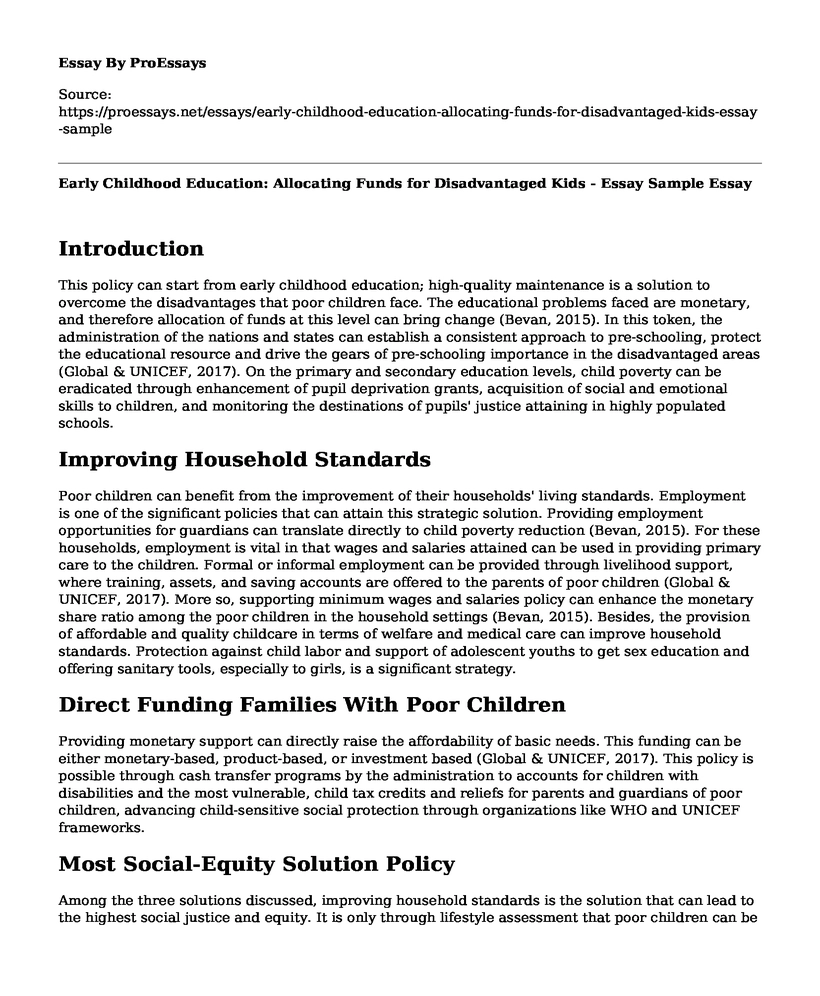Introduction
This policy can start from early childhood education; high-quality maintenance is a solution to overcome the disadvantages that poor children face. The educational problems faced are monetary, and therefore allocation of funds at this level can bring change (Bevan, 2015). In this token, the administration of the nations and states can establish a consistent approach to pre-schooling, protect the educational resource and drive the gears of pre-schooling importance in the disadvantaged areas (Global & UNICEF, 2017). On the primary and secondary education levels, child poverty can be eradicated through enhancement of pupil deprivation grants, acquisition of social and emotional skills to children, and monitoring the destinations of pupils' justice attaining in highly populated schools.
Improving Household Standards
Poor children can benefit from the improvement of their households' living standards. Employment is one of the significant policies that can attain this strategic solution. Providing employment opportunities for guardians can translate directly to child poverty reduction (Bevan, 2015). For these households, employment is vital in that wages and salaries attained can be used in providing primary care to the children. Formal or informal employment can be provided through livelihood support, where training, assets, and saving accounts are offered to the parents of poor children (Global & UNICEF, 2017). More so, supporting minimum wages and salaries policy can enhance the monetary share ratio among the poor children in the household settings (Bevan, 2015). Besides, the provision of affordable and quality childcare in terms of welfare and medical care can improve household standards. Protection against child labor and support of adolescent youths to get sex education and offering sanitary tools, especially to girls, is a significant strategy.
Direct Funding Families With Poor Children
Providing monetary support can directly raise the affordability of basic needs. This funding can be either monetary-based, product-based, or investment based (Global & UNICEF, 2017). This policy is possible through cash transfer programs by the administration to accounts for children with disabilities and the most vulnerable, child tax credits and reliefs for parents and guardians of poor children, advancing child-sensitive social protection through organizations like WHO and UNICEF frameworks.
Most Social-Equity Solution Policy
Among the three solutions discussed, improving household standards is the solution that can lead to the highest social justice and equity. It is only through lifestyle assessment that poor children can be identified from the household to household visitation where much is portrayed in terms of the nutrition programs, available sleeping facilities, type of housing, and clothing by the vulnerable families (Bevan, 2015). Therefore just solutions and aids can be offered based on the results, and through the household improvement, social setting is unified.
Personal Preferable Solution Selection
Personally, if I were to choose a solution method, I would not prioritize the above discussed highest justice attaining policy but would prefer the provision of equity and quality education. Reason giving pillars to this choice- the education policy is a very attainable practice to every corner of the society, while congregated together, it is not hectic to identify needy children and offer them the requirements needed for a sustainable academic life (Global & UNICEF, 2017). Although this solution does not give an entity of justice in terms of other social care to the eradication of child poverty, it is an easy and permanent solution for the sector. Education is the key to success thence directly or indirectly, the possibility of future low-income families is minimized.
References
Bevan, S. (2015, August 4). Seven ways to reduce child poverty. Retrieved from https://www.bevanfoundation.org/commentary/seven-ways-reduce-child-poverty/
Global, C., & UNICEF. (2017, March 4). Milestone 4 Reducing child poverty through policy. Retrieved from https://www.unicef.org/socialpolicy/files/Child_Poverty_SDG_Guide-Milestone_4-March_2017.pdf
Cite this page
Early Childhood Education: Allocating Funds for Disadvantaged Kids - Essay Sample. (2023, May 18). Retrieved from https://proessays.net/essays/early-childhood-education-allocating-funds-for-disadvantaged-kids-essay-sample
If you are the original author of this essay and no longer wish to have it published on the ProEssays website, please click below to request its removal:
- Essay Sample on Emergent Bilinguals Education Policy
- 3 Types of Schooling: Homeschooling, Public & Private
- Zone of Proximal Development: Benefits for Teaching - Essay Sample
- Paper Example on Social Inequality at California State University
- A Strategic Leadership Plan: A Personal Vision, Mission, and SMART Goals - Essay Sample
- Free Paper Sample: Interest in Education Assistant Role
- Critical Thinking Controversial Images Example







